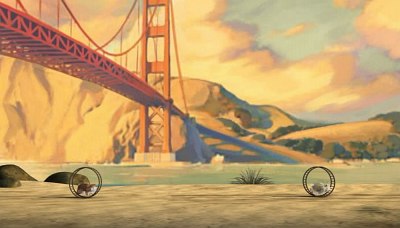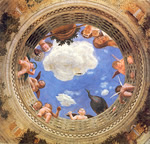Bob
Film info
Title: Bob
Running time: 3 min.
Director: Jacob Frey & Harry Fast
Country of origin: Germany, 2009
Language: no dialogue
Suggested age group: 11-14 years
Synopsis
A hamster picking up a glimpse of a female companion is willing to do anything to win her heart - even chasing her around the world. But a big surprise is awaiting him...
Main themes
Stereotypes
Gender expectations
Following instinct
Coming out / outing
In BOB the concept of chasing one another through various environments turns out to be nothing but a trick of the eye. The camera angle makes it look as if the landscapes on posters in a travel agency are the real location of the action. This deceptive viewpoint can be a starting point for various exercises:
Exercise 1: Backgrounds
Some well known exercises might be an entertaining start in exploring backgrounds and perspectives. For the first exercise you need to be able to project pictures on a big screen or wall using either a computer and projector, slides or an overhead projector.
Using slides showing 5 different landscapes:
- Hand out colour copies of the pictures, one copy per student. They should keep the pictures hidden from each other. Ask each student to write a description of the landscape in his picture, not describing details but focusing on the overall impression. Collect all pictures in a box.
- Have students pick one description out of the box. One by one ask them to read it out loud. Does the description match with the picture projected on the screen? Can the students decide which description goes with which picture? Does this produce a comic effect? (The more extreme your choice of pictures, the more likely you will obtain a comic contrast.)
- Write a neutral text about a news item, not being too specific about the context – do not specify the location but write in a general tone. For instance: “Many people gathered to protest against etc.” or “This historical environment was the perfect location for a peaceful meeting of etc.” Let the students read the text out loud, standing in front of the slides. Does the location pictured in the background change the interpretation of the news item? How? Does it produce a comical effect?
- Have students bring in or call up a picture of their favourite holiday destination. This could be a place where they’ve actually been on holidays, or one that they want to visit in the future. Standing in front of the picture, projected on the screen, ask them to describe the scenery in the picture and what special attraction it has for them. Stimulate them to use the picture background in a creative way, as a part of their explanation.
Exercise 2: Perspective I
In this film perspective is used to deceive the audience. Have the students watch the film again and identify
- the exact moment when you understood what the real setting was;
- impossibilities in the use of perspective (like the treadmill bumping over a rock) etc.);
- Focussing on the touristic pictures used as backgrounds in Bob:
- Which locations are shown?
- In what country?
- Which continent?
- Where would you like to visit?
Exercise 3: Perspective II
We all know those holiday pictures in which a certain perspective creates a funny effect (like a tourist in front, acting as if he is pushing over the Leaning Tower of Pisa in the background, or a man leaning his arm on top of the Eiffel tower).
- Can the students find such trompe l’oeil pictures on the internet?
Changing the perspective can offer you a completely different view on a situation, as in the famous example where a close up appears to show a man aggressively pushing a woman over the pavement. However, from a distance we see the man is pushing the woman because a heavy object is falling from a window and might crush her.
Can the students come up with similar settings for such pictures in which a broader perspective changes the interpretation of the image? Try to emphasise the duality in emotions (crying in pain -> crying from happiness; shouting fearfully -> shouting from excitement etc).
Choose the best ideas and let the students use a camera to capture those images.
Exercise 4: Imagine ... Animation or feature?
Everything is possible in an animated film. Even the craziest ideas can be visualized on screen. But what about a feature film, in which actors have to depict certain situations?
What could or could not be done if BOB were to be remade as a feature film? (other than the fact that you would need to replace hamsters by humans)?
Exercise 5: Recognizing sexes
In our first encounter with Bob we clearly identify 'him' as a female. Later on we clearly recognise 'him' as a male.
What makes us recognise a person’s gender?
Why do we – as opposed to the hamster in the film – seldom make mistakes?
Do we know we don’t make mistakes?
Try to compare Bob’s performance in the beginning and at the end of the movie. How do the characters differ?
What are the differences in body language, carriage, attitude, physical appearance? (Pay attention to physical details such as chest, chin, eyes,…).
Can you identify the moment when the film maker is transforming the female into a male? How does he do that?
How do we usually recognise the sex of people that we meet so easily?
Even at a very young age, children draw boys and girls differently. How do they do that?
Draw a page with several ‘eggs’ at the top of the page in a row next to each other: faces with no further attributes. Distribute some pages of eggs amongst the pupils.
- Let the students work in pairs. Ask one of the pair to draw a face on 3 ‘eggs’. How do they make clear whether it’s a boy or a girl? Can partners easily identify the gender of the characters? Can the draughtsman change the gender of the painted character with one or two pencil strokes? How do you turn a boy into a girl and vice versa?
- The same can be done with silhouettes? How do you recognize a boy’s silhouette from a girl’s? Is it the waist, the hips, the legs? How is it in real life? Compare the shape of a boy’s and a girl’s body, taking in consideration only the secondary sexual elements.
- They can now use clothing and accessories to turn the silhouettes into males or females. What attributes do they use for boys and girls? Make a list of the attributes that were used. Are these really typical accessories? Discuss the stereotypes in their choice.
Discussion: There are biological reasons why our minds rarely make mistakes in recognising other people’s sex. Can the students find out why our minds are organised that way?
Were some students ever mistaken for a member of the other sex? Were some boys ever mistaken for girls or vice versa? How do they feel about that? Is it the same for the boys as for the girls? Is a tomboy (girl) more easily accepted than an effeminate boy?











